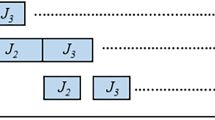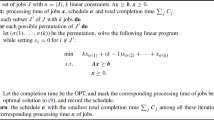Abstract
This paper studies on-line scheduling in a single-processor system that allows preemption. The aim is to maximize the total value of jobs completed by their deadlines. It is known that if the on-line scheduler is given a processor faster (say, two times faster) than the off-line scheduler, then there exists an on-line algorithm called \({\text{SLACKER}}\) that can achieve an O(1) competitive ratio. In this paper, we show that using additional unit-speed processors instead of a faster processor is a possible but not cost effective way to achieve an O(1) competitive ratio. Specifically, we find that-Θ(log k) unit-speed processors are required, where k is the importance ratio. Another contribution of this paper is an improved analysis of the competitiveness of \({\text{SLACKER}}\); this new analysis enables us to show that \({\text{SLACKER}}\), when extended to multi-processor systems, can still guarantee an O(1) competitive ratio.
Similar content being viewed by others
REFERENCES
Baruah, S., “Overload tolerance for single-processor workloads,” in IEEE Symp. on Real Time Technology and Application, 1998, pp. 2-11.
Baruah, S., G. Koren, D. Mao, B. Mishra, A. Raghunathan, L. Rosier, D. Shasha, and F. Wang, “On the competitiveness of on-line real-time task scheduling,” J. Real-Time Syst., 4, 124-144 (1992).
Baruah, S., G. Koren, B. Mishra, A. Raghunathan, L. Rosier and D. Shasha, “On-line scheduling in the presence of overload,” in Proc. IEEE 32nd Annu. Symp. on Foundations of Computer Science, San Juan, Puerto Rico, 1991, pp. 101-110.
Berman, P. and C. Coulston, “Speed is more powerful than clairvoyance,” in Proc. 6th Scand. Workshop on Algorithm Theory, Stockholm, Sweden, 8–10 July, 1998, pp. 255-263.
Borodin, A. and R. El-Yaniv, Online Computation and Competitive Analysis. Cambridge University Press, Cambridge, United Kingdom, 1998.
Brehob, M., E. Torng, and P. Uthaisombut, “Applying extra-resource analysis to load balancing,” in Proc. 11th Annu. ACM-SIAM Symp. on Discrete Algorithms, San Francisco, California 2000, pp. 560-561.
Dertouzos, M. L., “Control robotics: the procedural control of physical processes,” in Proc. IFIP Congress, 1974, pp. 807-813.
Edmonds, J., in “Scheduling in the dark,”, in Proc. 31st Annu. ACM Symp. on Theory of Computing, 1999, pp. 179-188.
Kalyanasundaram, B. and K. R. Pruhs, “Maximizing job completions online,” in Proc. 6th Eur. Symp. on Algorithms, 1998, pp. 235-246.
Kalyanasundaram, B. and K. R. Pruhs, “Speed is as powerful as clairvoyance,” J. ACM, 47(4), 617-643 (2000).
Koren, G., “Competitive on-line scheduling for overloaded real-time systems,” Department of Computer Science, New York University, 1993.
Koren, G. and D. Shasha, “MOCA: A multiprocessor on-line competitive algorithm real-time system scheduling,” Theoretical Comput. Sci., 128, 75-97 (1994).
Koren, G. and D. Shasha, “Dover: An optimal on-line scheduling algorithm for overloaded uniprocessor real-time systems,” SIAM J. Computing, 24, 318-339 (1994).
Lam, T. W. and K. K. To, “Trade-offs between speed and processor in hard-deadline scheduling,” in Proc. 10th Annu. ACM-SIAM Symp. on Discrete Algorithms, 1999, pp. 623-632.
Lam, T. W. and K. K. To, “Performance guarantee for online deadline scheduling in the presence of overload,” in Proc. 10th Annu. ACM-SIAM Symp. on Discrete Algorithms, 2001, pp. 755-764.
Cynthia A. P., C. Stein, E. Torng, and J. Wein, “Optimal time-critical scheduling via resource augmentation,” in Proc. 29th Annu. ACM Symp. on Theory of Computing, El Paso, Texas, 1997, pp. 140-149.
Sgall, J., “On-line scheduling—a survey,” in A. Fiat and G. Woeginger (eds), On-line Algorithms: The State of the Art, Lecture Notes in Computer Science, Springer and Verlag, 1998, pp. 196-231.
Stankovic, J., M. Spuri, K. Ramamritham, and G. Buttazzo, Deadline Scheduling for Real-time Systems EDF and Related Algorithms, Kluwer Academic Publishers Boston, MS, 1998.
Author information
Authors and Affiliations
Rights and permissions
About this article
Cite this article
Koo, CY., Lam, TW., Ngan, TW. et al. Competitive Deadline Scheduling via Additional or Faster Processors. Journal of Scheduling 6, 213–223 (2003). https://doi.org/10.1023/A:1022998111685
Issue Date:
DOI: https://doi.org/10.1023/A:1022998111685




